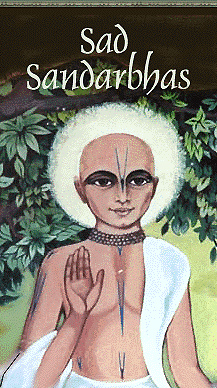
BY: SUN STAFF
Dec 13, CANADA (SUN) —
Tattva Sandarbha
by Srila Jiva Goswami
SECTION SEVENTEEN
Further, the Prabhasa Khanda of the Skanda Purana states (5.3.121,122): >
"O best of the twiceborn, I consider the meaning and importance of the Puranas as firm as that of the Vedas. Without doubt all the subject matter of the Vedas exists in the them. The Vedas fear the man of petty knowledge thinking he will twist the meaning; therefore, in the past the meaning of the Vedas was fixed by means of the Itihasas and Puranas. What is not found in the Vedas is found in Smriti, but what is not found in both of these is found in the Puranas. A person is not considered learned if he does not know the Puranas, even if he has studied the four Vedas along with the Vedangas and Upanishads."
Although the authority of the Puranas has been established, the same doubt remains--that their ultimate meaning is also difficult to comprehend by contemporary men of paltry intelligence--because the Puranas are also not available in their entirety and generally they try to establish the supremacy of different deities. As stated in the Matsya Purana (53.65,68,69):
A Purana has five characteristics as opposed to an Akhyana. (The scriptures are divided into three classes--sattvika, rajasika, and tamasika.) The glory of Lord Hari is greater in the sattvika Puranas; the glory of Lord Brahma is more in the rajasika Puranas; the glory of Lord Siva and Agni is more in the tamasika Puranas. In the mixed scriptures the glory of Sarasvati and the Pitris is explained."
Here the word Agni refers to the various sacrifices performed in fire. The word "ca" (and) in "sivasya ca" includes the wife of Lord Siva, Durga; "sankirna" means the various scriptures in the mixed modes of sattva, rajas, and tamas. "Sarasvati", refers to the scriptual statements that indicate the different deities. The sruti says, "karmana pitrilokah", by fruitive activities one can attain the abode of the manes; thus the word "pitri" in the verse refers to such fruitive activities.
Sri Jiva Toshani Commentary
The verse cited from the Matsya Purana refers to the five charactristics of a Purana. These characteristics are given in another verse of the Matsya Purana, 53.65:
"Creation, dissolution, genealogy, manvantaras and descriptions of the activities of famous kings, these are the five characteristics of a Purana." A detailed discussion of these five occur later in Sri Tattva Sandarbha, Sections 57 and 61.
The eighteen Puranas have been classified into three divisions namely the modes of goodness, passion, and ignorance. In the verses cited from the Matsya Purana giving these three divisions the word kalpa is used for scriptures or Puranas, but there is a difference of opinion about its meaning in this context. Kalpa also refers to a day of Brahma and some commentators on the Matsya Purana have used it in this way; however, that meaning is not fitting in this context. According to the Medini Sanskrit Dictionary (1.21.2), kalpa sastre vidhau nyaye samvarte brahmane dine, "Kalpa means scripture, rule, logic, dissolution, and day of Brahma". Of all these meanings, "scripture" reads best in this context. To use "day of Brahma" here would imply that there are days of Brahma in goodness, passion, or in ignorance, but there is no scriptural support for such a notion. Radha Mohan Bhattacarya, an authorized commentator on Tattva Sandarbha, has explained that kalpa means "scripture like the Puranas and so on." He is not alone in his conclusion, because some editions of the Matsya Purana read "purana" in place of kalpa. This is further substantiated by the following verses from the Padma Purana, Uttara Khanda ( 236. 18-21), which explicitly state that the eighteen Puranas are divided according to the three modes of nature.:
"Lord Siva said: O beautiful lady, know that the Vishnu, Narada, Bhagavata, Garuda, Padma and Varaha Puranas are sattvika; the Brahmanda, Brahma-vaivartta, Markandeya, Bhavishya, Vamana and Brahma Puranas are rajasika; and the Matsya, Kurma, Linga, Siva, Skanda and Agni Puranas are tamasika."
The verses Srila Jiva cites from the Skanda Purana imply that the Puranas are as good as the Vedas and should be accepted as such by whoever accepts the Vedas. There are many commentaries on the Vedas, but the Puranas are the natural commentary written by Srila Vyasa, the compiler of the Vedas. The message of the Vedas, therefore, can be understood by study of the Puranas alone, even without studying the Vedas. On the other hand without studying the Puranas, study of the Vedas is incomplete and therefore study of the Puranas is even more important and complete than study of the Vedas. The statement that no one can become learned without studying the Puranas suggest that they are more important than the Itihasas.
But just as there are difficulties in studying the Vedas, similar difficulties are encountered in studying the Puranas. The eighteen major Puranas and eighteen minor Puranas together are a vast body of literature to study, and there are no current disciplic successions for most of these Puranas. Some portions are not available and some have variant readings, and like the Vedas, the conclusion is unclear because each Purana seems to establish a different deity as the supreme. The Siva Purana proclaims Lord Siva to be supreme; the Vishnu Purana proclaims Lord Vishnu as supreme, and so on. The result is confusion for one who studies them without proper guidance. He will not know whether to worship Siva, Vishnu, Devi, or some other deity.
Srila Jiva Gosvami gives the solution to this problem in the next section.
Go to Section Twenty
Return to Section Sixteen
